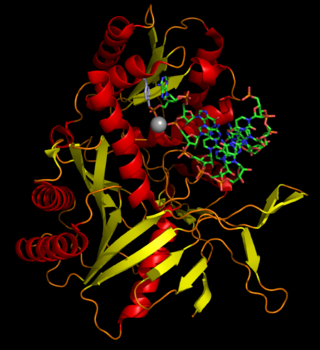
The Bacillota are a phylum of bacteria, most of which have gram-positive cell wall structure. The renaming of phyla such as Firmicutes in 2021 remains controversial among microbiologists, many of whom continue to use the earlier names of long standing in the literature.

The Clostridia are a highly polyphyletic class of Bacillota, including Clostridium and other similar genera. They are distinguished from the Bacilli by lacking aerobic respiration. They are obligate anaerobes and oxygen is toxic to them. Species of the class Clostridia are often but not always Gram-positive and have the ability to form spores. Studies show they are not a monophyletic group, and their relationships are not entirely certain. Currently, most are placed in a single order called Clostridiales, but this is not a natural group and is likely to be redefined in the future.
The Deferribacteraceae are a family of gram-negative bacteria which make energy by anaerobic respiration.

Archaeoglobaceae are a family of the Archaeoglobales. All known genera within the Archaeoglobaceae are hyperthermophilic and can be found near undersea hydrothermal vents. Archaeoglobaceae are the only family in the order Archaeoglobales, which is the only order in the class Archaeoglobi.

In taxonomy, the Thermoplasmataceae are a family of the Thermoplasmatales. It contains only one genus, Thermoplasma. All species within Thermoplasmataceae are thermoacidophiles, and they grow at a temperature of 60°C and pH 2. They were isolated from hydrothermal vents, fumaroles and similar environments.

The Bacillaceae are a family of gram-positive, heterotrophic, rod-shaped bacteria that may produce endospores. Motile members of this family are characterized by peritrichous flagella. Some Bacillaceae are aerobic, while others are facultative or strict anaerobes. Most are not pathogenic, but Bacillus species are known to cause disease in humans.
The Halanaerobiales are an order of bacteria placed within the class Clostridia, and encompassing two families, the Halanaerobiaceae and the Halobacteroidaceae. Originally placed within the highly polyphyletic class Clostridia, according to the NCBI and LPSN, it is now thought to lie outside the Bacillota. Halanaerobiales are halophilic obligate anaerobes with a fermentative or homoacetogenic metabolism.
The Myxococcota are a phylum of bacteria known as the fruiting gliding bacteria. All species of this group are Gram-negative. They are predominantly aerobic genera that release myxospores in unfavorable environments.
Caldicellulosiruptor is a genus of thermophilic, anaerobic, Gram-positive, non-spore forming bacteria. Originally placed within the highly polyphyletic class Clostridia, order Thermoanaerobacterales and family Thermoanaerobacterales Family III according to the NCBI and LPSN, it is now thought to lie outside of the Bacillota. Caldicellulosiruptor is known to degrade and ferment complex carbohydrates from plant matter, such as cellulose and hemicellulose, and certain species in the genus have been identified as potential candidates for biofuel production.
The phylum Elusimicrobiota, previously known as "Termite Group 1", has been shown to be widespread in different ecosystems like marine environment, sewage sludge, contaminated sites and soils, and toxic wastes. The high abundance of Elusimicrobiota representatives is only seen for the lineage of symbionts found in termites and ants.
The Thermaerobacter are an unassigned genus of bacteria placed within the class clostridia. Originally placed within the highly polyphyletic class Clostridia, order Clostridiales, according to the NCBI and LPSN, it is now thought to lie outside of the Bacillota.

The Erysipelotrichia are a class of bacteria of the phylum Bacillota. Species of this class are known to be common in the gut microbiome, as they have been isolated from swine manure and increase in composition of the mouse gut microbiome for mice switched to diets high in fat.
The Selenomonadales are an order of bacteria within the class Negativicutes; unlike most other members of Bacillota, they are Gram-negative. The phylogeny of this order was initially determined by 16S rRNA comparisons. More recently, molecular markers in the form of conserved signature indels (CSIs) have been found specific for all Selenomonadales species. On the basis of these markers, the Selenomonadales are inclusive of two distinct families, and are no longer the sole order within the Negativicutes. Several CSIs have also been found specific for both families, Sporomusaceae and Selenomonadceae. Samples of bacterial strains within this order have been isolated from the root canals of healthy human teeth.
Moorella is a genus of bacteria belonging to the phylum Bacillota.
Halanaerobium is a gram-negative, non-endospore-forming, rod-shaped, and strictly anaerobic genus of bacteria from the family Halanaerobiaceae.
Natrialbales is an order of halophilic, chemoorganotrophic archaea within the class Haloarchaea. The type genus of this order is Natrialba.
Halorubraceae is a family of halophilic, chemoorganotrophic or heterotrophic archaea within the order Haloferacales. The type genus of this family is Halorubrum. Its biochemical characteristics are the same as the order Haloferacales.
Bdellovibrionota is a phylum of bacteria.
Thermosediminibacteraceae is a family of Gram positive bacteria in the class Clostridia.
Tepidanaerobacteraceae is a family of Gram positive bacteria in the class Clostridia.




